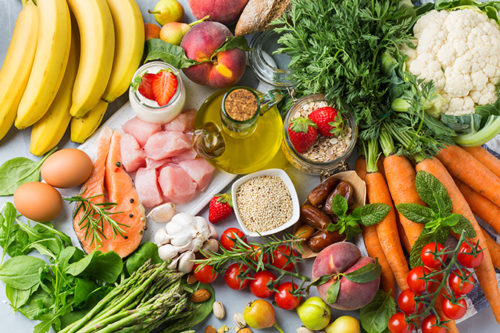It can be challenging to eat healthy. Food groups keep changing, fast food is quick and convenient, advertising is confusing and our daily lives are moving faster. But if there’s one thing we need to do every day, it’s eating five or more fruits and vegetables – and in a rainbow of colors. Are you eating the recommended five colors a day?
 When I was growing up, we were taught about the “Basic Four” food groups: dairy, meat, grain, fruits and vegetables. Later, the “Food Guide Pyramid” was introduced with six categories: grains, fruits, vegetables, protein, dairy, and fats/oils/sweets group. Most recently there has been another change in USDA nutrition guidelines with the introduction of “MyPlate” launched in 2011. MyPlate includes fruits, vegetables, grains, protein and dairy.
When I was growing up, we were taught about the “Basic Four” food groups: dairy, meat, grain, fruits and vegetables. Later, the “Food Guide Pyramid” was introduced with six categories: grains, fruits, vegetables, protein, dairy, and fats/oils/sweets group. Most recently there has been another change in USDA nutrition guidelines with the introduction of “MyPlate” launched in 2011. MyPlate includes fruits, vegetables, grains, protein and dairy.
This can make healthy eating confusing at times. However, one thing that has not changed is consuming five different colors of fruits and vegetables per day including:
- Red
- Orange / yellow
- Green
- Blue / purple
- White
 This is something that I have been reminded of as I train Oasis volunteers to teach children nutrition lessons as part of the intergenerational CATCH Healthy Habits program. It’s exciting for kids and adults to brainstorm the color spectrum of fruits and vegetables, often discovering new foods. It’s recommended that we consume five different colors of fruits and vegetables per day including:
This is something that I have been reminded of as I train Oasis volunteers to teach children nutrition lessons as part of the intergenerational CATCH Healthy Habits program. It’s exciting for kids and adults to brainstorm the color spectrum of fruits and vegetables, often discovering new foods. It’s recommended that we consume five different colors of fruits and vegetables per day including:- Red fruits and vegetables such as tomatoes, red onions, strawberries, beets, watermelons, guavas and apples, which contain powerful antioxidants that may reduce the risk for certain cancers (skin, breast, prostate), heart disease, control high blood pressure and slow some effects of aging
- Orange/yellow fruits and vegetables such as corn, tangerines, carrots, pineapple and pumpkin contain carotenoids, bioflavonoids, vitamin C, vitamin E and folate which help to maintain healthy good vision and eyesight, help reduce risk of certain cancers and heart disease, and improve immune system function
- Green fruits and vegetables such as broccoli, cabbage, lettuce, peas, spinach and other “greens,” (i.e., green apples and grapes), contain vitamins, minerals, fiber and phytochemicals which work with the chemicals in other foods to help keep eyes healthy, reduce the risk of cataracts, in addition to protecting against some cancers
- Blue/purple fruits and vegetables such as blueberries, blackberries, purple grapes, raisins, figs, eggplant contain flavonoids, phytochemicals and antioxidants such as anthocyanins that protect cells from damage. Blue/Purple produce may also reduce the risk of certain cancers, stroke, heart disease and complications from diabetes. Some studies have also shown a link to improved memory function and healthy aging
- White fruits and vegetables such as mushrooms, onions, shallots, garlic, bananas, potatoes and cauliflower contain healthy chemicals such as the phytonutrient allicin and healthy minerals like potassium. White produce may lower cholesterol and control blood pressure, in addition to reducing the risk of heart disease, infection and certain cancers
I challenge everyone to think about the colors you are eating the next time you are sitting down to or planning a meal or event, shopping at your local market, or harvesting your garden. The foods you serve can save your life.
Next time … delicious and creative ways you can consume the daily rainbow.






Leave A Comment
You must be logged in to post a comment.